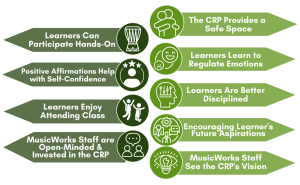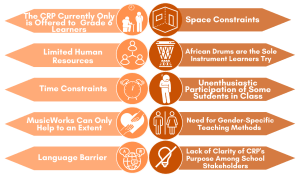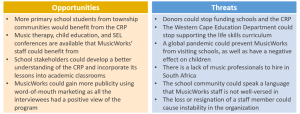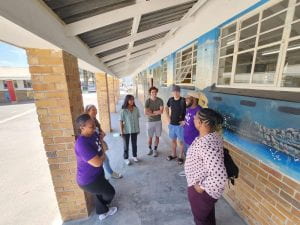Assessing MusicWorks’ Creative Resilience Program
Project Sponsor: Raymond Schuller and Alexanne Tingley, MusicWorks
Team Members: Donny Crowley, Hannah George, Jonathan Golden, and Sequoia Truong
Advisors: Professors Gbetonmasse Somasse and Thidinalei Tshiguvho

IQP Team with project liaison Raymond Schuller
View the SWOT Analysis Deliverable
Abstract
MusicWorks, a nonprofit organization in Cape Town, developed the Creative Resilience Program (CRP) to nurture the resilience and self-esteem of Grade 6 learners from marginalized communities, through social-emotional learning and music therapy. We evaluated the impacts of the program through surveys, student drawings, lesson observations, interviews with stakeholders, and a SWOT analysis. Our findings revealed that the program supports the development of resilience and individual growth in its students. This evaluation, which measures the impact of the CRP, could help increase the program’s funding and outreach.
Executive Summary
The Context of the CRP
MusicWorks is a nonprofit organization in Cape Town, South Africa, whose work supports learners in developing resilience to adversities they face in their lives, thereby promoting students’ individual development. The Creative Resilience Program (CRP), a recent addition to MusicWorks’ selection of programs, was introduced in 2020 in response to the COVID-19 pandemic, the subsequent lockdown, and the potential mental and psychosocial distress resulting from these events. The CRP worked with groups of Grade 6 children over the course of 10 months to nurture their resilience through music and other creative techniques. The program is unique due to the collaboration of community musicians and music therapists, and its use of both social-emotional learning (SEL) techniques and music interventions within their lessons.
In 2022, MusicWorks conducted the CRP in four schools located in Cape Town and its surrounding communities. We collaborated with MusicWorks to evaluate the program’s ability to nurture its learners’ resilience and individual growth, and to identify the strengths of the program as well as areas of improvement. This evaluation is intended to provide MusicWorks with a third-party perspective of their program and recommendations for improving the program for future learners.
Goal and Objectives
The goal of the project is to assess the CRP’s impact on nurturing its learners’ resilience and individual growth. To meet that goal, we identified the following objectives:
- Identify the adversities that MusicWorks’ students face that require the development of their resilience.
- Assess the effectiveness of the CRP in nurturing the students’ self-esteem.
- Determine the students’ perceptions of the CRP.
- Determine strengths and weaknesses of the CRP through the perspective of the principals, school teachers, session facilitators, and directors of MusicWorks.
- Conduct a SWOT analysis for MusicWorks to strengthen the CRP.
Using the data collected for these objectives, we discuss below the key findings and recommendations.
Findings and Analysis
Learners’ Diverse Backgrounds and Living Conditions
Using information collected from interviews with principals, teachers, music facilitators, and MusicWorks directors, we identified four consistent themes that describe the context of the learner’s backgrounds and the adversities that require their resilience. These themes that shape the learners’ environments and thus, affect their emotional well-being, are: unstable family relations, physical and emotional abuse, stressful community experiences, and poverty and substandard living conditions.
Self-Esteem Scores of the CRP’s Learners
Since the CRP aims to use social-emotional learning to support and nurture the self-esteem of their learners, assessing this quality is critical to determine the program’s impact. We measured learners’ self-esteem at Woodlands and St. Vincent primary schools using two surveys: one which was previously administered by MusicWorks; and a second which we designed to align with the Rosenberg Self-Esteem Scale, on which self-esteem values range from lowest at zero to highest at 30. We found that at the end of the program, learners at both schools had self-esteem scores between 15 and 22, indicating average to high self-esteem.
Key Strengths of the CRP
Interviews with school teachers, principals, music session facilitators, and MusicWorks directors revealed nine attributes of the CRP that support learners’ resilience and individual growth. These attributes include aspects from both the music interventions and the social-emotional learning portions of the lessons.

Key Strengths of the CRP
Key Weaknesses of the CRP
Analysis of data collected from interviews, feedback surveys, student drawings, and observation, revealed ten areas of improvement of the CRP that limit the program’s success. These are aspects of the program that, if improved, could increase the program’s growth and impact on its learners.

Key Weaknesses of the CRP
Opportunities and Threats
The opportunities and threats are factors that are external to MusicWorks, which, although the organization does not have control over, are important to consider for the program’s success. Using a SWOT analysis, we identified opportunities and threats for the CRP that MusicWorks could consider for program planning and implementation.

Opportunities and Threats of the CRP
Recommendations
Based on the identified strengths of the CRP, we came up with a list of recommendations for MusicWorks to implement to improve the efficacy of the program.
- Increase Fundraising Efforts: By having more fundraisers, reaching out to more donors, and promoting word-of-mouth marketing, MusicWorks could increase its opportunity to secure more funds, which would help them hire more staff members. This would allow the program to expand to more schools and lower grades, thereby increasing its reach on young learners throughout Cape Town and surrounding areas.
- Increase Stakeholders’ Understanding of the Program: By running an example session of the CRP with principals and teachers of the schools the CRP operates at, explaining the intentions behind activities, and encouraging teachers to use similar techniques, MusicWorks’ key stakeholders will have a better understanding of how the program is run. This could increase the support and prioritization that MusicWorks’ CRP receives. It would also be helpful to create an agreement between each school and MusicWorks that discusses the CRP’s schedule throughout its duration, and establishes good communication between each school and MusicWorks.
- Work Towards a More Well-Rounded Team: In order to achieve a team well-versed in music therapy, SEL, and child education, the areas on which CRP intervention is based, MusicWorks could have its staff attend relevant workshops, conferences, and other events. These conferences could also increase exposure for MusicWorks, possibly resulting in attention from more potential donors and future staff recruits.
- Improve the CRP’s Curriculum: MusicWorks could improve the CRP’s curriculum by better-aligning its lessons with the Department of Basic Education’s life skills curriculum, and by creating a curriculum for Grade 5 learners. We also recommend that they continue to assess the impact of the curriculum on students’ self-esteem by conducting our Modified Rosenberg Self-Esteem Survey and MusicWorks Evaluation Survey.
- Connect to Other Student Support Systems at the Schools: We recommend that MusicWorks staff serve on their schools’ School Based Support Teams, which are already established in schools to assist classroom and subject teachers to develop and implement strategies that support pupil learning. This would assist MusicWorks in providing students with more support systems.
Overall, our evaluation highlights the CRP’s success of combining SEL and music interventions to nurture the resilience of Grade 6 learners.

IQP Team with MusicWorks community musicians at St. Vincent Primary School


